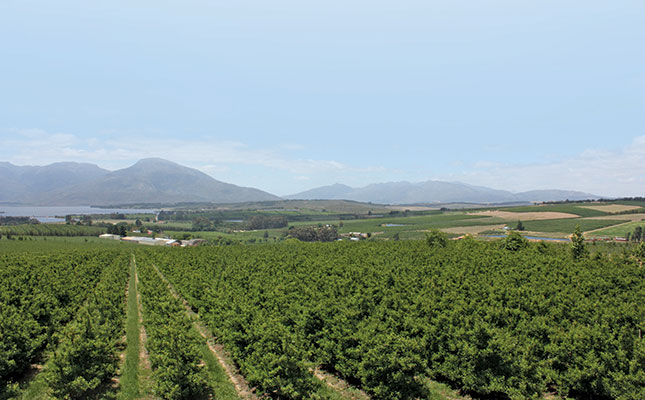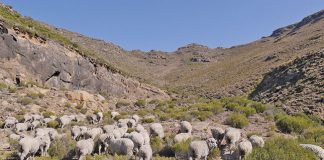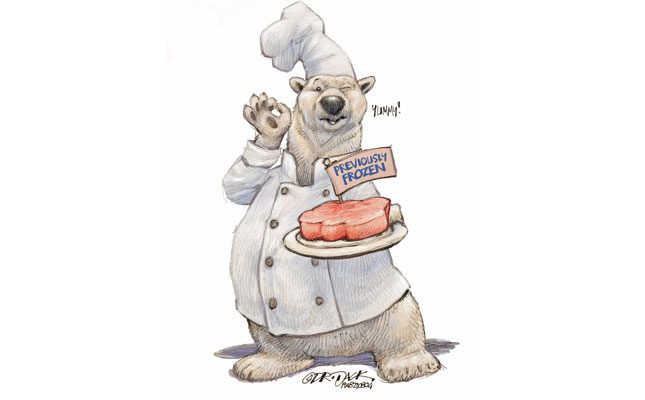
Meat is composed of about 60% to 70% of naturally occurring water. This makes meat and its products more prone to microbial spoilage and chemical reactions that can negatively affect quality characteristics such as colour, texture and flavour.
Freezing meat is therefore a great way to preserve its nutritional value and keep it from spoiling by mainly reducing the rate of microbial spoilage and deterioration.
Depending on the cut, type of meat and packaging, uncooked meats may be preserved in the freezer and remain at a high quality for anywhere from one to 12 months.
the advantages of freezing meat
Food safety
Freezing has been proven to decrease potentially harmful bacteria, which can be the source of food poisoning. As long as meat is stored in an appropriate manner and proper directions are followed for thawing and cooking, frozen meat is very safe.
The few outbreaks of foodborne illnesses associated with frozen meat and other foods indicate that some, but not all, human pathogens are killed by the freezing process.
Improved meat texture
It may be appealing to meat lovers to purchase a steak from the shop and cook it immediately. However, research has shown that freezing the steak and cooking it later actually improves the tenderness of certain cuts.
Freezing has been shown to cause muscle fibres to swell and rupture, resulting in improved tenderness. To prove this, the Agricultural Research Council’s (ARC) meat science team assessed loin steaks for tenderness using the Warner-Bratzler (WB) shear force test, which measures the force needed to shear the meat.
The steaks were aged for three, six and nine days prior to freezing. The steaks were then thawed and cooked before the test. Fresh steaks were cooked immediately after storage/ageing and tested. The results showed the steaks that were frozen-thawed prior to cooking were more tender (lower WB) than the fresh steaks (see Graph 1). In addition, extended ageing periods coupled with freezing are more favourable to meat tenderness.
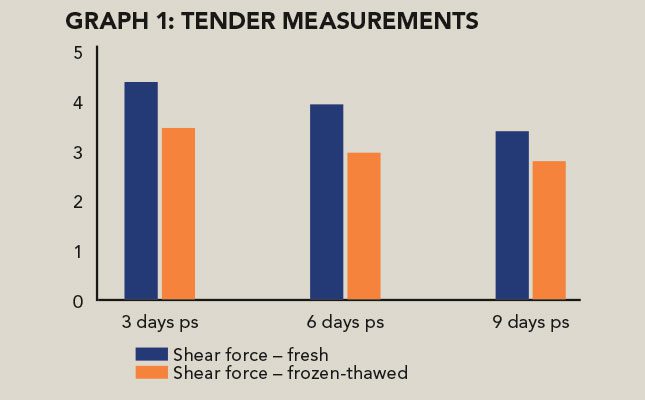
Disadvantages of freezing meat
Increased meat discoloration
We all know that colour is often viewed as the number one factor used by consumers when purchasing beef, other than cost. Consumers usually avoid meat that has discoloured and look for an attractive, bright cherry-red colour when buying meat. Therefore, maintaining a bright cherry-red colour is a common concern for the meat industry in attracting consumers.
Frozen thawed meat loses this bright cherry-red colour during thawing. This is due to the leaching of myoglobin exudate of meat during thawing. (Myoglobin is a protein that gives meat its colour.) It has also been shown that myoglobin loses its natural qualities during freezing and thawing, which is to give meat its bright, cherry-red colour.
There is also accumulation of metmyoglobin, which gives meat a brownish colour. Myoglobin and metmyoglobin concentrations were measured using a Minolta colour meter.
Frozen-thawed meat has a very high concentration of metmyoglobin and a low concentration of myoglobin, and this worsens as the meat is stored/aged for extended periods before freezing. Metmyoglobin is the cause of the characteristic brown colouration that usually appears on the surface of the meat.
Increased drip/purge
Drip loss is a very important meat quality characteristic in the meat industry. It is the fluid that is lost from meat during thawing. When meat is frozen, ice crystals are formed within the structure of the meat, and these crystals rupture the fibres and fluid drips out during defrosting.
The reddish fluid that seeps out during defrosting contains water, iron and proteins from the meat. The fluid loss often causes dehydration and nutrient loss in frozen meat. This can make frozen-thawed meat drier than fresh meat, depending on the duration and method of freezing.
This aspect is economically detrimental due to loss yield (weight) and loss of soluble nutrients. It also causes the meat to have an unattractive appearance. Frozen-thawed meat has close to 6% drip loss compared with fresh meat’s 2,4% after the meat has been stored for three days (see Graph 2).
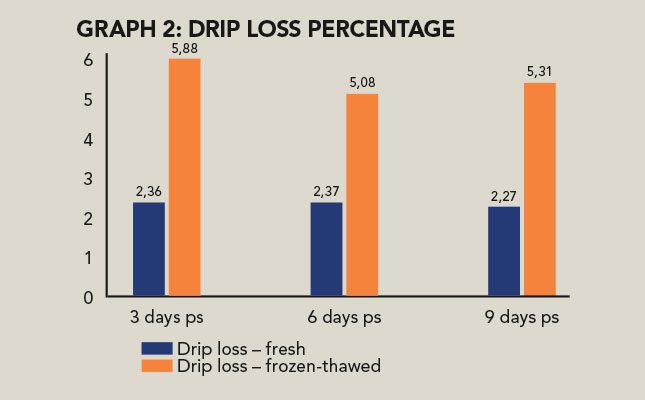
Importance of correct labelling
Although frozen-thawed meat has the advantage of being more tender than fresh meat, other quality characteristics such as colour, drip loss and flavour are compromised, as explained above.
Therefore, labelling is necessary to inform the consumer that they are buying meat with some compromised quality characteristics. Scientific studies have proven that consumers are prepared to pay extra for superior-quality meat products with guaranteed tenderness in conjunction with leanness, juiciness and flavour.
According to the Government Gazette of 21 April 2023, foodstuffs that were frozen and thawed for subsequent sale must not be labelled fresh. These foodstuffs must indicate ‘previously frozen’ on the package.
To authenticate that this meat labelling regulation is adhered to, the ARC’s meat science team has put in place a method that can distinguish the differences between fresh and frozen-thawed meat.
This method uses a proteomics approach to assess proteins that are denatured (proteins that have their characteristic properties destroyed) by freezing. Preliminary results have shown that the protein myoglobin, which contributes to the cherry-red colour, was observed to decrease in frozen-thawed meat compared with fresh meat.
This shows that this protein is lost during defrosting. Therefore, through labelling, consumers will make an informed choice.
The views expressed in our weekly opinion piece do not necessarily reflect those of Farmer’s Weekly.
Email Dr Kedibone Modika at [email protected].











